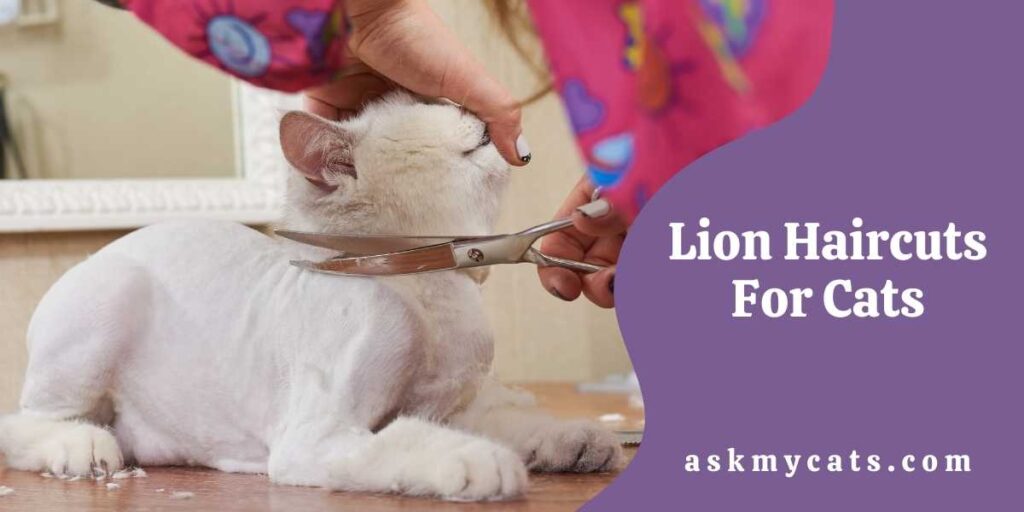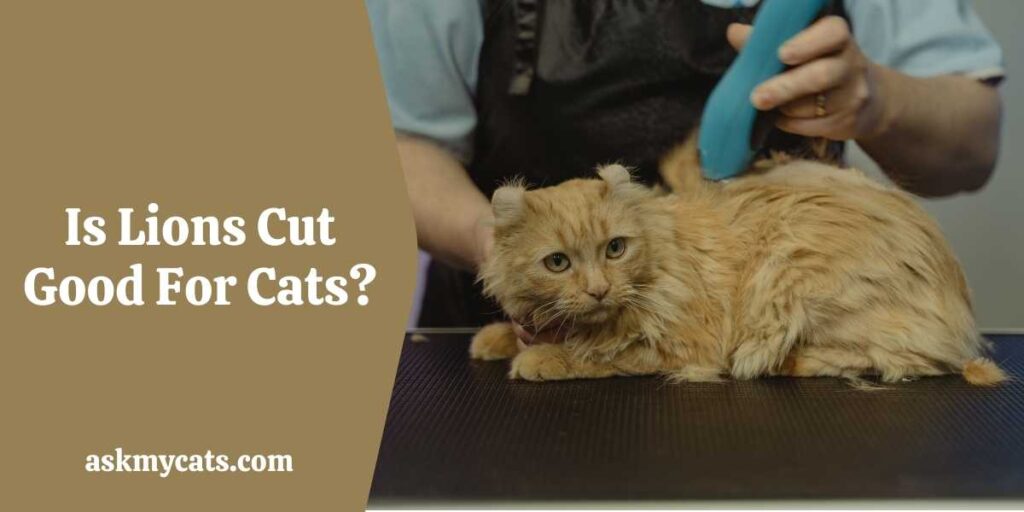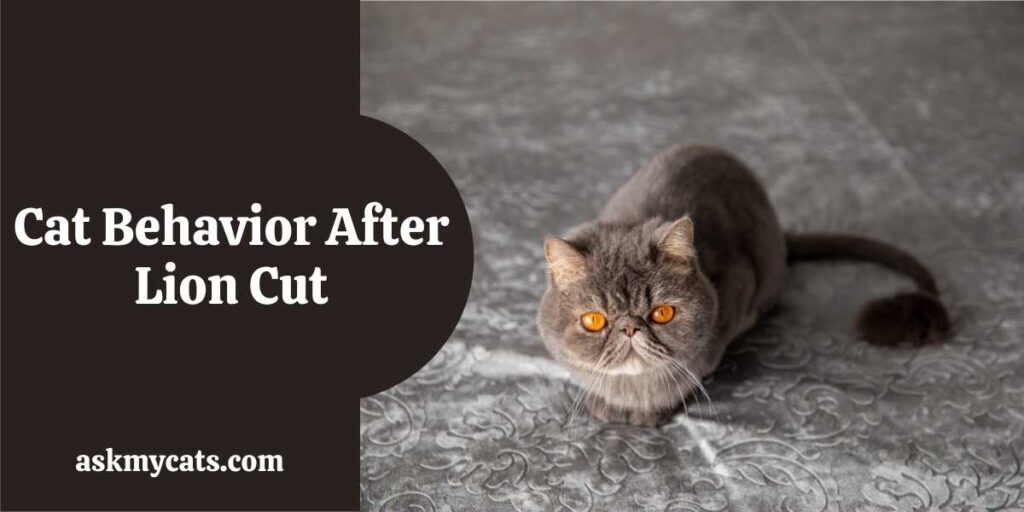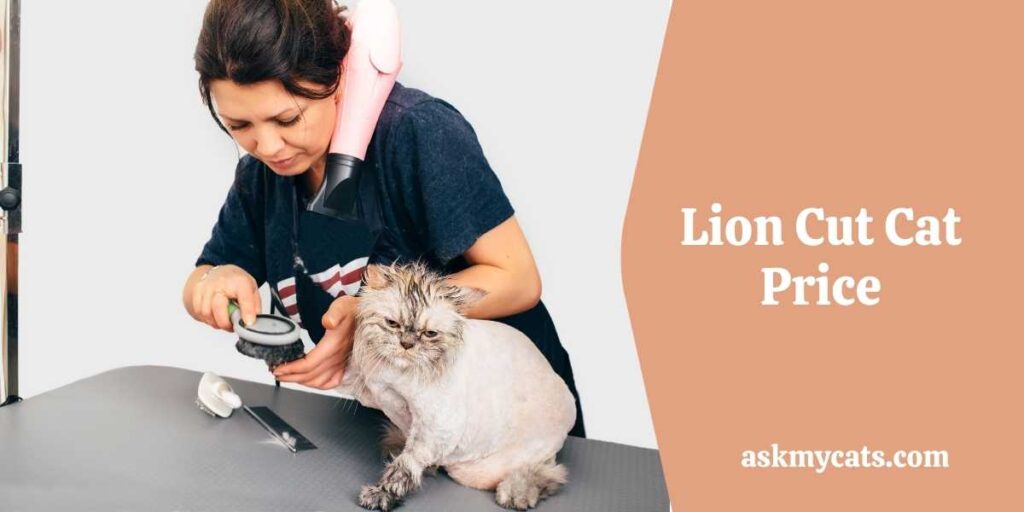If you have a long-haired cat, there are times when taking him to a groomer that specializes in lion cuts for cats is a good idea.
Although lion cuts aren’t always the best option, this approach of shaving a cat’s body while leaving his face and neck fur alone might be helpful during scorching seasons or if your cat is prone to matting.
A lion cut is a long-haired cat’s fur style in which the cat’s body is trimmed almost to the skin.
There are a few variations on the cut, but the basic look leaves the cat with very short fur on his body and legs, while his face, neck, and most, if not all, of his tail, is left alone.


Give Your Cat the Perfect Day
Get the Free Ebook!
Is Lions Cut Good For Cats?
Lion’s cut is not suitable for every cat.

A Lion Cut is not required for every cat, and even for particular long-haired cats that undergo this grooming style, it is not always needed.
However, there are several reasons why this cut is beneficial to cats.
Long-haired (and occasionally mid-length) cats are more prone to matting in their fur; therefore, lion cuts usually are reserved for them.
If grooming your cat necessitates cutting or shaving the hair, please see a professional to avoid harming your cat. A lion cut might be advantageous for a variety of reasons.
The most typical reason for getting a lion cut for your cat is because the fur is matting. When a long-haired cat’s fur becomes tangled and cannot be combed out, the tangles must be removed with scissors (not advised) or shaving.
The longer the mats are in place, the more likely the skin beneath them may become inflamed or injured. If the matting is left too long, the cat will grow increasingly uncomfortable with it, eventually becoming painful. The irritated skin is caused by the matted fur pulling at it.
Cats that have lost their ability to groom themselves. If cats don’t groom themselves regularly, they can become more prone to unclean and matted fur as they become older or don’t desire to brush themselves even when they are younger (if at all).
In the spring or early summer, some people may have their cat trimmed with the lion cut to relieve the heat. Some owners may keep the lion cut year if their cat is indoor and their home is heated in the winter.
In the winter, outdoor cats will often let their fur grow long to keep warm.
When one or more individuals in your household have cat allergies, a lion cut can help to decrease the impact allergies have on those who suffer from them.
Several owners get their cats trimmed using the lion cut to prevent shedding in the house. Even though many short-haired cats shed a lot of furs, they may be groomed with a decent brush, wash, and blow-dry. For a limited time, this will minimize shedding in the home.
Cat Behavior After Lion Cut
Typically, cats dislike the grooming procedure during the lion cut but like the sensation of the cut afterwards.

Do not utilize sedation during the grooming procedure, but be prepared with gloves and a cone if a cat becomes agitated. We shall be protected against bites and scratches as a result of this.
Surprisingly, some cats are relatively peaceful during the procedure, and others even seem to like it.
Baths are not mandatory but are available upon request. Some cats can’t stand being blown dry after a bath, so they’re towelled and dried as much as possible. Please bring a blanket or a dry towel with you on the way home after they’ve had a bath to keep them warm.
A lion cut is a shaved grooming technique in which the majority of the hair on the cat’s body is removed using specialist clippers, but the hair is left on a few minor spots.
Hair is left on the forehead and head, the bottom part of all four paws, and the tip of the tail in a conventional lion cut.
As previously said, the lion cut is best for long-haired cats and isn’t necessary for shorter-haired cats. The lion cut can grow more lethal as the cat ages and is deemed elderly. Some cats will not accept this form of grooming, depending on their age and fragility.
Cats’ skin thins as they become older, making them more vulnerable to nicks and wounds. Talk to your groomer to find out if your cat is a good candidate.
Lion Cut For Cats Pros
While cats with lion cuts have a lot of flairs, it’s not usually the reason they’re shaved. There are various reasons why giving your cat this cut, at least temporarily, maybe an intelligent choice.
1. Easier Maintenance
Grooming is essential for long-haired cats. While most cats groom themselves, long-haired types require extra attention.
To aid with shedding and eliminate matting, their fur should be brushed or combed once a week. Cat owners who are short on time may discover that trimming their long-haired cats into a lion cut reduces the necessary maintenance.
2. Eliminating Mats And Hairballs
Mats may form in the cat’s fur if it is not brushed regularly or has difficulty grooming itself. If left alone, these mats can twist, squeeze, or otherwise injure the skin beneath them, resulting in open sores.
Cats with many rugs or fur that are badly matted might benefit from a lion cut to help them deal with the condition.
When the weather becomes warmer, and your cat starts to shed, your long-haired breed may be more prone to hairballs. As the cat combs his shedding fur, he may eat more than his digestive system can safely handle.
This can result in vomiting, choking, or intestinal blockages, all of which might necessitate surgery. This challenge is solved by clipping the fur into a lion cut.
3. Trouble With Self-Care
Your cat may have trouble keeping himself clean and well-groomed if he is elderly, chubby, or sad. Because they may not be able to reach all of their furs, cats with longer hair may have more difficulties with self-care as they age.
Finally, weird as it may sound, some cats are plain lousy at grooming themselves. Your cat will be able to self-groom more successfully if you cut them into a lion cut.
4. Excessive Heat
Your long-haired cat may struggle to cope with the heat if you live in a hot environment. Lion cuts drastically decrease a cat’s fur, allowing her to keep more relaxed during the hottest months.
5. Reduces Shedding
Giving your cat a lion cut won’t truly lessen the quantity of hair he sheds, but it will appear to you that there is less hair being deposited around the home since the hairs will be much shorter. Some human allergy patients may benefit from this as well.
Lion Cut For Cats Cons
While the lion cut is generally advantageous to both cats and humans, it has certain disadvantages.
1. Stressed Out
Some cats may not mind getting shaved, but it may be stressful for others. Lion cuts are generally administered at a veterinarian facility or a pet groomer, which requires travel in the vehicle and puts your cat in an unusual atmosphere.
Some cats may need to be sedated before being clipped due to their nervousness. Cats may also be irritated by being shaved in general, exhibiting strange behaviours like hiding, refusing to eat, and sadness.
2. Sunburn
If your cat spends time outside, a lion cut can make their skin more vulnerable to the sun’s damaging rays, resulting in irritation and sunburn. Cats with paler fur will be considerably more susceptible.
This has nothing to do with the season since a cat can become sunburned and windburned in winter and summer.
Shaved cats also have more fragile skin, which means they are more susceptible to cuts, scratches, and other irritations without their fur to protect them.
It’s advisable to keep your cat indoors all year if you’re going to give them a lion cut.
3. No Body Temperature Regulation
Fur is one of the ways that animals, including cats, regulate their body temperature.
You would believe that a shaved cat will be more relaxed in the summer, but if they lose their ability to thermoregulate, they might get overheated or too cold.
If cats are shaved, they are more likely to develop this issue, and certain medical conditions, such as cancer and heart disease, may make shaving inadvisable.
Lion Cut Cat Price
Each visit for your cat’s lion cut can cost anything from $80 to $120 or more on average.

The cost of keeping your cat in a lion cut for a long time might mount up.
Depending on how thick your cat’s fur is, how quickly it grows, and how quickly mats or other issues appear, you may need to see the groomer or doctor every month.
Frequently Asked Questions
How often does a cat need a lion haircut?
A Lion Cut should be done every 8-12 weeks, while nail caps should be changed every six weeks. This allows the cat to groom on a regular and familiar (rather than frightening) basis.
How long does lion cut last?
If you give your cat a lion cut for the first haircut and later decide that you and your cat would be better with his “natural look,” his hair will grow back entirely in a few months. It should take roughly three months on average for a short-haired breed.
Do cats hate lion cuts?
Many cat owners claim that after getting a lion cut, their cats are happier and more lively, and this fact alone keeps them coming back for more.
Final Words
A lion cut can assist many long-haired cats with many of the issues that long-haired breeds experience. If any of these problems emerge, consider having your cat’s fur cut, and enjoy her new appearance while it lasts.
Ask your questions in the comments section below.
